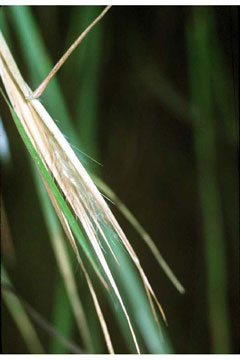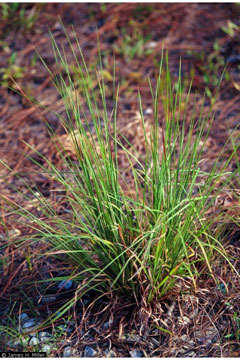 |
|
Robert H. Mohlenbrock @ USDA-NRCS PLANTS Database / USDA SCS. 1991. Southern wetland flora: Field office guide to plant species. South National Technical Center, Fort Worth. |
 |
| James H. Miller @ USDA-NRCS PLANTS Database / Miller, J.H. and K.V. Miller. 2005. Forest plants of the southeast and their wildlife uses. University of Georgia Press, Athens |
Translate this page:
Summary
A perennial grass forming narrow clumps of stems with some medicinal and other uses. Common names include broomsedge bluestem, yellowsedge bluestem and whiskey grass in Australia as it was used as American whiskey bottle packaging.
Physical Characteristics

 Andropogon virginicus is a PERENNIAL growing to 1.2 m (4ft).
Andropogon virginicus is a PERENNIAL growing to 1.2 m (4ft).
See above for USDA hardiness. It is hardy to UK zone 6. It is in flower from September to October. The species is hermaphrodite (has both male and female organs) and is pollinated by Wind.
Suitable for: light (sandy) soils and prefers well-drained soil. Suitable pH: mildly acid, neutral and basic (mildly alkaline) soils and can grow in very acid soils.
It cannot grow in the shade. It prefers dry or moist soil.
UK Hardiness Map
US Hardiness Map
Synonyms
Plant Habitats
Woodland Garden Sunny Edge; Cultivated Beds;
Edible Uses
References More on Edible Uses
Medicinal Uses
Plants For A Future can not take any responsibility for any adverse effects from the use of plants. Always seek advice from a professional before using a plant medicinally.
Astringent Salve
A decoction of the roots is used in the treatment of backaches[222]. A tea made from the leaves is used in the treatment of diarrhoea[222]. Externally, it is used as a wash for frostbite, sores, itching, piles and poison ivy rash[222, 257].
References More on Medicinal Uses
The Bookshop: Edible Plant Books
Our Latest books on Perennial Plants For Food Forests and Permaculture Gardens in paperback or digital formats.

Edible Tropical Plants
Food Forest Plants for Hotter Conditions: 250+ Plants For Tropical Food Forests & Permaculture Gardens.
More

Edible Temperate Plants
Plants for Your Food Forest: 500 Plants for Temperate Food Forests & Permaculture Gardens.
More

More Books
PFAF have eight books available in paperback and digital formats. Browse the shop for more information.
Shop Now
Other Uses
A yellow dye is obtained from the stems[257]. Onion skins are sometimes added when making the dye[257]. Sometimes grown as an ornamental plant (but can be weedy).
Special Uses
References More on Other Uses
Cultivation details
Requires a light porous sandy soil in full sun[200]. Plants are often found in very acid soils in the wild[236]. This plant was inadvertantly introduced to the Hawain Islands in 1932 and has spread widely there. It is considered to be one of the most threatening of exotic species, invading native habitats and altering the fire and hydrology regimes[274].
References Carbon Farming Information and Carbon Sequestration Information
Temperature Converter
Type a value in the Celsius field to convert the value to Fahrenheit:
Fahrenheit:
The PFAF Bookshop
Plants For A Future have a number of books available in paperback and digital form. Book titles include Edible Plants, Edible Perennials, Edible Trees,Edible Shrubs, Woodland Gardening, and Temperate Food Forest Plants. Our new book is Food Forest Plants For Hotter Conditions (Tropical and Sub-Tropical).
Shop Now
Plant Propagation
Seed - surface sow in early spring in a greenhouse. When large enough to handle, prick the seedlings out into individual pots and grow them on for the first winter in a cold greenhouse. Plant out in late spring or early summer, after the last expected frosts. Division in spring.
Other Names
If available other names are mentioned here
Native Plant Search
Search over 900 plants ideal for food forests and permaculture gardens. Filter to search native plants to your area. The plants selected are the plants in our book 'Plants For Your Food Forest: 500 Plants for Temperate Food Forests and Permaculture Gardens, as well as plants chosen for our forthcoming related books for Tropical/Hot Wet Climates and Mediterranean/Hot Dry Climates. Native Plant Search
Found In
Countries where the plant has been found are listed here if the information is available
Weed Potential
Right plant wrong place. We are currently updating this section.
Please note that a plant may be invasive in one area but may not in your area so it’s worth checking.
Invasive in Hawaii and California and weedy in other areas of the US. Releasing persistent herbicidal chemicals to competes with other species. Fire tolerant.
Conservation Status
IUCN Red List of Threatened Plants Status : Least Concern.

Growth: S = slow M = medium F = fast. Soil: L = light (sandy) M = medium H = heavy (clay). pH: A = acid N = neutral B = basic (alkaline). Shade: F = full shade S = semi-shade N = no shade. Moisture: D = dry M = Moist We = wet Wa = water.

Expert comment
Author
L.
Botanical References
200236
Links / References
For a list of references used on this page please go here
Readers comment
| Add a comment |
|
If you have important information about this plant that may help other users please add a comment or link below. Only comments or links that are felt to be directly relevant to a plant will be included. If you think a comment/link or information contained on this page is inaccurate or misleading we would welcome your feedback at [email protected]. If you have questions about a plant please use the Forum on this website as we do not have the resources to answer questions ourselves.
* Please note: the comments by website users are not necessarily those held by PFAF and may give misleading or inaccurate information.
To leave a comment please Register or login here All comments need to be approved so will not appear immediately.
|
Subject : Andropogon virginicus
|
|
|
|